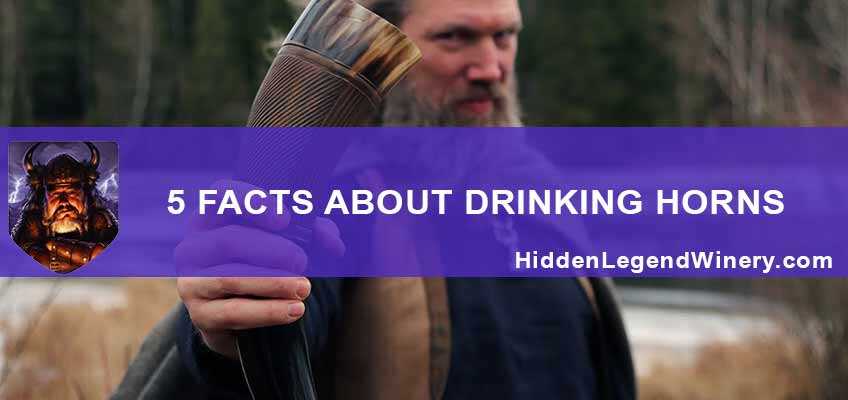
5 Interesting Facts About Viking Drinking Horns
Five facts about Viking drinking horns and how they relate to mead
You’ve probably seen Viking drinking horns on television or in mead promotions, wondering if they’re authentic or just a cool bit of art in media. While they are neat things to see around, they aren’t just some made-up art piece but, rather a historical and culturally important chalice. The Viking drinking horn carries a long history and weaves through many customs still alive and well. Beyond being an aesthetically beautiful piece to drink mead from, Viking drinking horns have a fascinating story that represents the Nordic gods to rites of passage.
Discover the beauty and craftsmanship of Viking drinking horns while indulging in the rich history of mead—a perfect pairing for any Viking enthusiast! Whether you’re looking for a unique addition to your collection or just want to experience the taste of history, explore our selection of meads and Viking-inspired gifts to bring the Norse spirit to life.
Take a look at the incredible gift options here that are perfect for pairing with your drinking horn, or check out a variety of delicious mead flavors from the experts at Hidden Legend Winery here. Find the perfect mead to savor as you raise your horn to the Vikings!
1. Viking Drinking Horns: A 2,000-Year-Old Tradition Beyond the Vikings
Viking drinking horns have been around for 2,600 years and probably even longer. Their uses have evolved from culture to culture as practical drinking utensils to ritualistic and ceremonial items. While they are best remembered for being prolific in Viking culture, they’ve been found to be used in ancient Rome, Greece, and the Celts. Everyone used these handy and fancy cups; we’ve just associated them with the Vikings.
2. Ancient Wisdom: Valuing Every Part of the Animal
Older societies weren’t known for their waste and many that prized hunting as more than a necessity believed wasting any part of the animal was an affront to the gods of nature. It took a lot of energy to track, trap, and hunt prey and so, why waste any part of what you’ve spent all day trying to catch? Viking drinking horns probably came into existence by older cultures trying to utilize every part of the animal. Lucky for us they held that sensical belief as now we have thousands of years of art to drink from. While it’s true that drinking horns weren’t always made from the horn of an animal, it is its most likely origin.
3. From Everyday Use to Family Heirlooms
If you see Viking drinking horns or other kinds of drinking horns in a museum, you’ll notice many of them tipped with various kinds of metals and most likely inscribed. Once drinking horns were shared around, though everyone made them independently from each other, people began producing them without the use of animals. They became family heirlooms and symbols of prestige or ceremonial importance. Many of the inscriptions in Viking drinking horns speak of what family they belong to, who they were passed down to, or something emblematic of the family.
4. Sacred Symbols Across Cultures and Religions
Important customs and ceremonial symbols are often tied to the divine and Viking drinking horns are no different. For example, in Greek mythology, it was believed that Dionysus held the drinking horn to be sacred. The Scythian tribe believed the drinking horn was given to a king from a god. Other cultures believed the Viking drinking horn to be a symbol of abundance or life, a necessary implement to praise the divine. Each society that created their own and separate Viking drinking horn tied it to their beliefs in significant ways. Even when Christianity replaced Paganism across Europe, the Viking drinking horn was associated with Christian beliefs.
5. Symbols of Celebration and Ritual
The Viking drinking horn, in every single culture that had one, was associated with alcohol and revelry. The pagan gods who were intertwined with the importance of the drinking horns were all the party gods, like Dionysus. With that, you’d probably think the drinking horns were mostly used to hold wine but, you’d be mistaken. Anything that was ritualistic significant to the culture would be in it and if we’re talking about the Viking drinking horn, it held mead. This cup of fun was so associated with revelry that slain warriors were offered a Viking drink horn when arriving at Valhalla.
Get Your Own Viking Drinking horn
Now that you know 5 interesting facts about Viking drinking horns, you’re probably thinking where you can get one. Well, you don’t have to go rummaging through a museum or settle for a plastic knock-off. If you’re going to drink mead and celebrate Scandinavian culture, why not go the full mile and drink from a real Viking drinking horn. Since we craft authentic mead, true to its lineage and history, we also pay homage to the Viking drinking horn. Made from real ox horn and can fit up to one pint, it’s the perfect addition to anyone who loves Viking culture.
When you lift up our Viking drinking horn, you’ll be carrying on a 2600-year-old legacy and celebrating an important part of nearly every ancient culture in the world. Ready to join the eternal party and sip mead like a real Viking?
Go here: https://www.hiddenlegendwinery.com/product/drinking-horn/
FAQ’s
1. What were Viking drinking horns typically made from?
Most Viking drinking horns were crafted from animal horns, often from cattle, as these were readily available and naturally shaped for holding drink. Skilled artisans would polish and clean these horns to be used as everyday drinking vessels. Wealthier Vikings occasionally owned drinking horns decorated with silver or ivory details, making them prized and often passed down as family heirlooms.
2. Were drinking horns used only by Vikings, or were they common in other cultures?
Although drinking horns are widely associated with the Vikings, they were actually popular in many ancient cultures. They were used in parts of Europe, Central Asia, and even the Caucasus. What sets Viking drinking horns apart is their symbolism and the unique ways they were crafted for different social gatherings, from everyday drinking vessels to ceremonial cups for leaders.
3. How did the shape of a Viking drinking horn impact its use?
The shape of Viking drinking horns made them distinct drinking vessels. Since they lack a flat base, they couldn’t be placed down easily, requiring drinkers to either empty the drink in one sitting or find a special holder to keep it upright. This design was practical and symbolized strength and social ritual, adding to the interesting and somewhat communal nature of drinking with a horn.
4. Were drinking horns used for all types of beverages?
Yes, Viking drinking horns were used to drink a variety of beverages, including beer, wine, and sometimes even water. Beer was a common drink for Vikings, while wine was more of a luxury, often reserved for special occasions or traded items from other regions. Drinking from a horn turned any beverage into a memorable experience, something the Vikings embraced.
5. Why are Viking drinking horns still considered unique today?
The quality and craftsmanship of Viking drinking horns make them unique, especially those with added materials like silver, ivory, or intricate carvings. Each drinking horn had a personal quality that reflected the owner’s status, making them amazing pieces of history. Today, many people collect them as fascinating artifacts or for use in historical reenactments, maintaining the tradition in a modern way.
6. Are Viking drinking horns still in use today?
Yes, Viking drinking horns have seen a resurgence in popularity! They’re used by history enthusiasts, for themed events, or as collector’s items. Modern drinking horns are crafted for both everyday use and as decorative pieces, and they’re designed with quality in mind to last. Brands make them with safe coatings for drinking, so you can enjoy your beer or wine from a horn, Viking-style.

Mead & Honey Wine – Complete Starter Guide
Raise A Glass To The Wonders Of Mead With These Gift Baskets